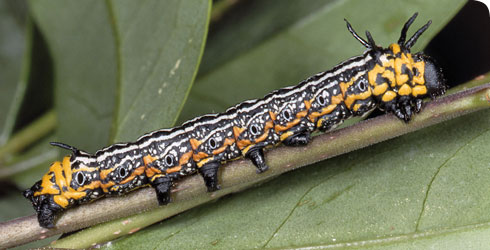Life cycle
1. Eggs are laid
The egg of Brahmaea europaea is small, round and yellowish.
Eggs are laid on the host plant, a species of ash, Fraxinus.
2. Larvae hatch
After a couple of weeks, a small larva hatches.
Larvae are
- brightly coloured with yellow, orange and white lines and spots on a black background.
- characterised by the presence of spiky processes on the thorax
- one near the posterior end (as is also seen in hawkmoths and several other related families of moths).
Larvae have also been found on green olive trees Phillyrea latifolia and raised on privet, Ligustrum vulgare, in captivity.
3. Larvae pupate
After undergoing four moults, the larva descends from the host plant in early summer to pupate underground.
The pupa possesses bands of spines (Akanthos in Greek means thorny) on the thorax and abdominal segments.The spines are used to anchor the pupal shell to the ground as the adult moth crawls out from the pupal chamber.
4. Adults emerge and try to breed
The adult moth emerges between March and April of the following year.
They fly from the end of March to May, for only a few hours each day, just after sunset. Interestingly, it seems that males start flying before the females, just as dusk begins.
As the adults do not feed, all they do in their short life (which rarely exceeds a week) is try to avoid predation and, most importantly, find a mate. The night after mating, the female lays a group of eggs on the food plant and the life cycle starts again.
